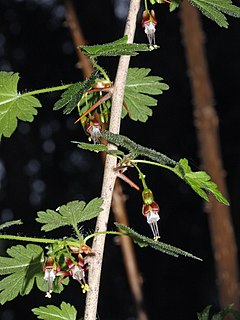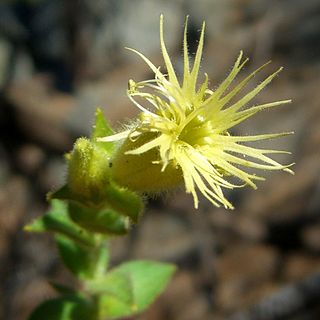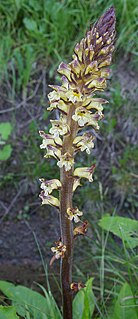
Orobanche is a genus of over 200 species of parasitic herbaceous plants in the family Orobanchaceae, mostly native to the temperate Northern Hemisphere. Some species formerly included in this genus are now referred to the genus Conopholis. The broomrape plant is small, from 10–60 cm tall depending on species. It is best recognized by its yellow- to straw-coloured stems completely lacking chlorophyll, bearing yellow, white, or blue snapdragon-like flowers. The flower shoots are scaly, with a dense terminal spike of between ten and twenty flowers in most species, although single in O. uniflora. The leaves are merely triangular scales. The seeds are minute, tan-to-brown, and blacken with age. These plants generally flower from late winter to late spring. When they are not flowering, no part of the plants is visible above the surface of the soil.

Orobanche aegyptiaca, the Egyptian broomrape, is a plant which is an obligate holoparasite from the family Orobanchaceae with a complex lifecycle. This parasite is most common in the Middle East and has a wide host range including many economically important crops.

Orobanche uniflora, commonly known as one-flowered broomrape, one-flowered cancer root, ghost pipe or naked broomrape, is an annual parasitic herbaceous plant. It is native to much of North America, where it is a parasitic plant, tapping nutrients from many other species of plants, including those in the families Asteraceae and Saxifragaceae and in the genus Sedum. The name "orobanche" can be translated to "vetch-strangler" and "uniflora" can be translated to "single-flower".

Allium parishii is an uncommon species of wild onion known by the common name Parish's onion. It is native to the Mojave Desert and Sonoran Deserts of California and Arizona. It grows on open dry, rocky slopes at elevations of 900–1,400 m (3,000–4,600 ft).

Ribes divaricatum is a species in the genus Ribes found in the forests, woodlands, and coastal scrub of western North America from British Columbia to California. The three accepted varieties have various common names which include the word "gooseberry".

Orobanche minor, the hellroot, common broomrape, lesser broomrape, small broomrape or clover broomrape, is a holoparasitic flowering plant belonging to the genus Orobanche; a genus of about 150 non-photosynthetic plants that parasitize other autotrophic plants.

Orobanche bulbosa is a species of plant known by the common name chaparral broomrape.

Orobanche californica, known by the common name California broomrape, is a species of broomrape. It is a parasitic plant growing attached to the roots of other plants, usually members of the Asteraceae.

Orobanche cooperi is a species of broomrape known by the common name Cooper's broomrapedesert broomrape, spike broomrape, and burroweed strangler. It is native to the desert regions of the southwestern United States and northern Mexico, where it is a parasite growing attached to the roots of other plants, usually members of the Asteraceae, such as Artemisia, Hymenoclea, Ambrosia and Encelia. Although not usually weedy, it has been found infesting agricultural cropland, including tomato fields in inland California. This plant arises from a thick root and a scaly, twisted stem base, and produces a thick, clumpy stem up to 40 centimeters tall. As a parasite taking its nutrients from a host plant, it lacks leaves and chlorophyll. It is dark purple in color and coated with glandular hairs. The inflorescence is an elongated array of several flowers. Each flower is tubular, purple and hairy, and up to about 3 centimeters long.

Orobanche corymbosa is a species of broomrape known by the common name flat-top broomrape. It is native to western North America where it is a parasite growing attached to the roots of other plants, usually sagebrush. It produces a cluster of thick, glandular stems with enlarged bases and stout roots, the hairy stems pale whitish or yellowish, often purple-tinged, and up to 17 centimetres (6.7 in) tall. As a parasite taking its nutrients from a host plant, it lacks leaves and chlorophyll. The inflorescence is a wide array of a few tubular flowers. Each is 2 centimetres (0.79 in) or 3 centimetres (1.2 in) long, coated in glandular hairs, and dark-veined pink or purple in color.

Orobanche fasciculata is a species of broomrape known by the common name clustered broomrape. It is native to much of western and central North America from Alaska to northern Mexico to the Great Lakes region, where it grows in many types of habitat. It is a parasite growing attached to the roots of other plants, usually members of the Asteraceae such as Artemisia; and other genres such as Eriodictyon and Eriogonum. This plant produces one or more stems from a thick root, growing erect to about 20 centimeters in maximum height. As a parasite taking its nutrients from a host plant, it lacks leaves and chlorophyll. It is variable in color, often yellowish or purple. The inflorescence is a raceme of up to 20 flowers, each on a pedicel up to 15 centimetres (5.9 in) long. Each flower has a calyx of hairy triangular sepals and a tubular corolla 1.5–3 centimetres (0.59–1.18 in) long. The flower is yellowish or purplish in color.
Orobanche pinorum is a species of broomrape known by the common name conifer broomrape. It is native to the forests of western North America, where it is a parasite growing attached to the roots of other plants, usually Holodiscus species. This plant has an erect stem with a wide, thickened base and slender top growing 10–30 centimetres (3.9–11.8 in) tall. As a parasite taking its nutrients from a host plant, it lacks leaves and chlorophyll and is brownish or yellowish in color. The inflorescence is a dense, spreading array of purple-tinged yellowish flowers 1–2 centimetres (0.39–0.79 in) long.

Orobanche ramosa is a species of broomrape known by the common names hemp broomrape and branched broomrape. It is native to Eurasia and North Africa, but it is known in many other places as an introduced species and sometimes a noxious weed.
Orobanche valida is a species of broomrape known by the common name Rock Creek broomrape. It is endemic to California, where its two uncommon subspecies grow in mountainous habitats separated by several hundred miles. Howell's broomrape, ssp. howellii, is limited to the North Coast Ranges north of the San Francisco Bay Area, where it grows in chaparral, often on serpentine soils. The similarly rare subspecies valida is known from only four occurrences in the Transverse Ranges. The plant is a parasite growing attached to the roots of other plants, generally shrubs; ssp. howellii can often be found on Garrya species. The plant produces a hairy, glandular purple stem up to about 35 centimeters tall. As a parasite taking its nutrients from a host plant, it lacks leaves and chlorophyll. The inflorescence is a small cluster of tubular purple flowers 1 to 2 centimeters long.

Orobanche vallicola is a species of broomrape known by the common name hillside broomrape.

Silene parishii is a species of flowering plant in the family Caryophyllaceae known by the common name Parish's catchfly. It is endemic to southern California, where it is known from several of the local mountain ranges, including the San Bernardino, San Gabriel, and San Jacinto Mountains. It grows in rocky, forested habitat, sometimes in the alpine climates of the higher peaks. It is a perennial herb growing from a woody, branching caudex and taproot, sending up several decumbent or erect stems 10 to 40 centimetres tall. The oppositely arranged leaves line the stems, the largest ones located at the middle of each stem. Leaves are lance-shaped to nearly oval and up to 6 centimetres long. They are thick and leathery, and sometimes glandular and sticky. Each flower is encapsulated in a tubular calyx of fused sepals which may be nearly 3 centimetres long. It is greenish with ten veins and a coating of glandular hairs. The five petals are yellowish in colour and each has about six long, fringelike lobes at the tip.

Orobanche rapum-genistae, the greater broomrape, is a plant species in the genus Orobanche. It is a parasitic plant, native to Europe, growing on the roots of plants in the bean family, usually common broom or European gorse.

Orobanche ludoviciana, the Louisiana broomrape or prairie broom-rape, is a species of plant in the family Orobanchaceae. This parasitic plant is not specific, but especially favors Artemisia and Asteraceae. They grow from 1-3 dm often without branches. Leaves are scales and numerous. The inflorescences are many-flowered spikes that occupy a half to a third of the shoot. Flowers sessile or with small up to 15mm pedicels for the lower flowers. Calyx subtended by 1 or 2 bracts, which are bilabiate. Corolla is 1.5-2.5 cm and often a violet-like color. 2n=24, 48, 72, 96. Inhabits sandy soil. Found in Illinois and Indiana, as well as Saskatchewan to Texas, and west to California and northern Mexico. Found from June through August. Listed as endangered in Wisconsin and threatened in Illinois and Indiana.

Orobanche hederae, the ivy broomrape, is, like other members of the genus Orobanche, a parasitic plant without chlorophyll, and thus totally dependent on its host, which is ivy. It grows to 60 cm (2 ft), with stems in shades of brown and purple, sometimes yellow. The flowers are 10–22 mm (0.4–0.9 in) long, cream in colour with reddish-purple veins.

Orobanche reticulata is a species of broomrape known by the common name thistle broomrape. It is a parasitic plant whose host is normally the creeping thistle. It is native to the lowlands of Western Europe and Central Asia, but in the United Kingdom it is a rare and protected plant, growing only in Yorkshire, on grassland sites such as Quarry Moor.



















